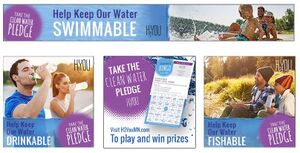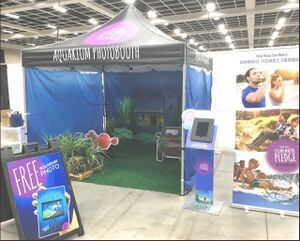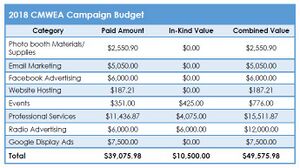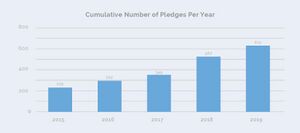
Difference between revisions of "Partnerships Case Study: Central Minnesota Water Education Alliance (CMWEA) Public Education and Outreach"
m () |
m |
||
| (3 intermediate revisions by the same user not shown) | |||
| Line 1: | Line 1: | ||
| − | |||
[[File:General information page image.png|left|100px|alt=image]] | [[File:General information page image.png|left|100px|alt=image]] | ||
[[File:Figure01 WebAdvertisingBanners.JPG|300px|thumb|alt=CMWEA advertising banners used for online advertising campaign|<font size=3>CMWEA advertising banners used for online advertising campaign</font size>]] | [[File:Figure01 WebAdvertisingBanners.JPG|300px|thumb|alt=CMWEA advertising banners used for online advertising campaign|<font size=3>CMWEA advertising banners used for online advertising campaign</font size>]] | ||
| Line 6: | Line 5: | ||
[[File:Figure04 2019CumulativePledges.jpg|300px|thumb|alt=2019 CWMEA cumulative number of pledges per year|<font size=3>2019 CWMEA cumulative number of pledges per year</font size>]] | [[File:Figure04 2019CumulativePledges.jpg|300px|thumb|alt=2019 CWMEA cumulative number of pledges per year|<font size=3>2019 CWMEA cumulative number of pledges per year</font size>]] | ||
| − | The [https://stormwater.pca.state.mn.us/index.php?title=Stormwater_Program_for_Municipal_Separate_Storm_Sewer_Systems_(MS4)#2020_MS4_General_Permit Phase II Small MS4 General Permit] requires small <span title="A municipal separate storm sewer system (MS4) is a means of transportation, individually or in a system, (e.g. roads with drainage systems, municipal streets, catch basins, curbs, gutters, ditches, man-made channels, storm drains, etc.) that are: owned or operated by a public entity (e.g. cities, townships, counties, military bases, hospitals, prison complexes, highway departments, universities, etc.) with jurisdiction over disposal of sewage, industrial wastes, stormwater, or other wastes. This includes special districts under State law (sewer, flood control, or drainage districts, etc.), an authorized Indian tribal organization, or a designated and approved management agency under Section 208 of the Clean Water; designed or used for collecting or transporting stormwater; not a combined sewer; and not part of a publicly owned treatment works."> '''MS4'''</span> (Municipal Separate Storm Sewer System) throughout Minnesota to adopt the following [https://stormwater.pca.state.mn.us/index.php?title=Stormwater_Program_for_Municipal_Separate_Storm_Sewer_Systems_(MS4)#Minimum_Control_Measures minimum control measures] to reduce pollution discharged to <span title="A stream, river, lake, ocean, or other surface or groundwaters into which treated or untreated wastewater is discharged"> '''receiving waters'''</span>: [https://stormwater.pca.state.mn.us/index.php?title=MCM_1_Public_Education_and_Outreach public education and outreach | + | The [https://stormwater.pca.state.mn.us/index.php?title=Stormwater_Program_for_Municipal_Separate_Storm_Sewer_Systems_(MS4)#2020_MS4_General_Permit Phase II Small MS4 General Permit] requires small <span title="A municipal separate storm sewer system (MS4) is a means of transportation, individually or in a system, (e.g. roads with drainage systems, municipal streets, catch basins, curbs, gutters, ditches, man-made channels, storm drains, etc.) that are: owned or operated by a public entity (e.g. cities, townships, counties, military bases, hospitals, prison complexes, highway departments, universities, etc.) with jurisdiction over disposal of sewage, industrial wastes, stormwater, or other wastes. This includes special districts under State law (sewer, flood control, or drainage districts, etc.), an authorized Indian tribal organization, or a designated and approved management agency under Section 208 of the Clean Water; designed or used for collecting or transporting stormwater; not a combined sewer; and not part of a publicly owned treatment works."> '''MS4'''</span> (Municipal Separate Storm Sewer System) throughout Minnesota to adopt the following [https://stormwater.pca.state.mn.us/index.php?title=Stormwater_Program_for_Municipal_Separate_Storm_Sewer_Systems_(MS4)#Minimum_Control_Measures minimum control measures] to reduce pollution discharged to <span title="A stream, river, lake, ocean, or other surface or groundwaters into which treated or untreated wastewater is discharged"> '''receiving waters'''</span>: [https://stormwater.pca.state.mn.us/index.php?title=MCM_1_Public_Education_and_Outreach public education and outreach], [https://stormwater.pca.state.mn.us/index.php?title=MCM_2_Public_Participation/Involvement public participation and involvement], [https://stormwater.pca.state.mn.us/index.php?title=MCM_3_Illicit_Discharge_Detection_and_Elimination illicit discharge detection and elimination], [https://stormwater.pca.state.mn.us/index.php?title=MCM_4_Construction_Site_Stormwater_Control construction site runoff control], [https://stormwater.pca.state.mn.us/index.php?title=MCM_5_Post-Construction_Stormwater_Management post-construction runoff control], and [https://stormwater.pca.state.mn.us/index.php?title=MCM_6_Pollution_Prevention/Good_Housekeeping pollution prevention / good housekeeping]. Prior to adoption of the Phase II Small MS4 General Permit, very little public stormwater education and outreach was being conducted by communities in Central Minnesota. To help small MS4s meet public education requirements, pool resources, and create consistent public education messaging, [https://h2youmn.com/ The Central Minnesota Water Education Alliance] (CMWEA) was formed in 2006. |
The CMWEA is a coalition of central Minnesota cities, counties, townships, and other organizations that provide educational outreach to promote water quality stewardship. The mission of CMWEA is to develop and implement educational programs that encourage individuals in Central Minnesota to protect water resources by increasing their knowledge and encouraging simple behavior changes. Since establishment, the CMWEA has expanded to also focus on wellhead protection plan education requirements for local communities. Although one goal of the CMWEA is to help small MS4s meet baseline public education requirements, the program has served as a driver to help small MS4s develop effective strategies and programs to address other related MS4 minimum control measure requirements by creating a network of resources and dedicated members. | The CMWEA is a coalition of central Minnesota cities, counties, townships, and other organizations that provide educational outreach to promote water quality stewardship. The mission of CMWEA is to develop and implement educational programs that encourage individuals in Central Minnesota to protect water resources by increasing their knowledge and encouraging simple behavior changes. Since establishment, the CMWEA has expanded to also focus on wellhead protection plan education requirements for local communities. Although one goal of the CMWEA is to help small MS4s meet baseline public education requirements, the program has served as a driver to help small MS4s develop effective strategies and programs to address other related MS4 minimum control measure requirements by creating a network of resources and dedicated members. | ||
| Line 14: | Line 13: | ||
Establishing consistent funding and staffing sources is an annual challenge for implementation of the CMWEA education and outreach efforts. Because the CMWEA does not have a dedicated staff to coordinate day to day tasks, the program relies on staff hour commitments from members. One effective method the CMWEA has implemented to establish a consistent revenue source is the establishment of annual membership dues. Over the years, the annual membership dues have been used to fund the core annual programs, with grants and in-kind donations used to enhance/augment the education program. Securing funding sources early in the development of the CMWEA to have a dedicated education coordinator staff/entity is one thing CMWEA members wish they would have considered in more detail earlier in development of the program. | Establishing consistent funding and staffing sources is an annual challenge for implementation of the CMWEA education and outreach efforts. Because the CMWEA does not have a dedicated staff to coordinate day to day tasks, the program relies on staff hour commitments from members. One effective method the CMWEA has implemented to establish a consistent revenue source is the establishment of annual membership dues. Over the years, the annual membership dues have been used to fund the core annual programs, with grants and in-kind donations used to enhance/augment the education program. Securing funding sources early in the development of the CMWEA to have a dedicated education coordinator staff/entity is one thing CMWEA members wish they would have considered in more detail earlier in development of the program. | ||
| − | More information regarding the history of the CMWEA, their educational programs & materials, and public education events can be found at the | + | More information regarding the history of the CMWEA, their educational programs & materials, and public education events can be found at the [https://h2youmn.com/ CMWEA website] or by contacting info@h2youmn.com. |
'''Project Location''': Central Minnesota<br> | '''Project Location''': Central Minnesota<br> | ||
| Line 26: | Line 25: | ||
'''Quantitative Outcomes''': In 2019, the CMWEA helped 17 MS4 members in Central Minnesota meet their MS4 public education and outreach requirements and implement wellhead protection plan objectives. A quantitative summary of their annual educational programs, member contributions, and annual budget can be found in CMWEA’s annual report by emailing info@h2youmn.com. CMWEA continued to use the Clean Water Pledge to promote clean water and how individual decisions collectively add up to healthier water for all. The Pledge was promoted at the | '''Quantitative Outcomes''': In 2019, the CMWEA helped 17 MS4 members in Central Minnesota meet their MS4 public education and outreach requirements and implement wellhead protection plan objectives. A quantitative summary of their annual educational programs, member contributions, and annual budget can be found in CMWEA’s annual report by emailing info@h2youmn.com. CMWEA continued to use the Clean Water Pledge to promote clean water and how individual decisions collectively add up to healthier water for all. The Pledge was promoted at the | ||
Aquarium Photo Booth, on social media, CMWEA website and in membership publications. The cumulative number of pledges per year has continually increased each year. | Aquarium Photo Booth, on social media, CMWEA website and in membership publications. The cumulative number of pledges per year has continually increased each year. | ||
| + | |||
| + | [[Category:Level 2 - Case studies and examples/Case studies]] | ||
| + | [[Category:Level 2 - Regulatory/Municipal (MS4)]] | ||
Latest revision as of 17:19, 8 December 2022
The Phase II Small MS4 General Permit requires small MS4 (Municipal Separate Storm Sewer System) throughout Minnesota to adopt the following minimum control measures to reduce pollution discharged to receiving waters: public education and outreach, public participation and involvement, illicit discharge detection and elimination, construction site runoff control, post-construction runoff control, and pollution prevention / good housekeeping. Prior to adoption of the Phase II Small MS4 General Permit, very little public stormwater education and outreach was being conducted by communities in Central Minnesota. To help small MS4s meet public education requirements, pool resources, and create consistent public education messaging, The Central Minnesota Water Education Alliance (CMWEA) was formed in 2006.
The CMWEA is a coalition of central Minnesota cities, counties, townships, and other organizations that provide educational outreach to promote water quality stewardship. The mission of CMWEA is to develop and implement educational programs that encourage individuals in Central Minnesota to protect water resources by increasing their knowledge and encouraging simple behavior changes. Since establishment, the CMWEA has expanded to also focus on wellhead protection plan education requirements for local communities. Although one goal of the CMWEA is to help small MS4s meet baseline public education requirements, the program has served as a driver to help small MS4s develop effective strategies and programs to address other related MS4 minimum control measure requirements by creating a network of resources and dedicated members.
The CMWEA was formed in 2006 with 8 original members (City of St. Cloud, Waite Park, Sartell, and St. Joseph, Stearns County, Stearns SWCD, Sauk River Watershed District and MN Rural Water Association). The lead entities of the group were the City of St. Cloud, Stearns County and Stearns SWCD, which is still the case today. The first year of the group was used to establish partnerships, funding sources, hire an advertising and marketing consultant, and develop a mission statement and goals, and initial funding for the group came from the Upper Mississippi River Source Water Protection Project and the Stearns County Water Management Plan. In 2019, CMWEA had 27 paying members and 3 advisory members (17 MS4 permittees, 9 source water protection members). Since 2007, CMWEA has used a professional marketing and advertising company to develop creative material and to assist with planning and implementation of a public education campaign. The CMWEA uses many strategies and programs to meet education requirements, ranging from social media advertising campaigns and radio advertising, to hosted workshops, educational display booths, and television commercial contests. To fund and staff education events and programs, CMWEA relies significantly on partnerships, grants and staff time from its members to operate a cost-effective program.
Establishing consistent funding and staffing sources is an annual challenge for implementation of the CMWEA education and outreach efforts. Because the CMWEA does not have a dedicated staff to coordinate day to day tasks, the program relies on staff hour commitments from members. One effective method the CMWEA has implemented to establish a consistent revenue source is the establishment of annual membership dues. Over the years, the annual membership dues have been used to fund the core annual programs, with grants and in-kind donations used to enhance/augment the education program. Securing funding sources early in the development of the CMWEA to have a dedicated education coordinator staff/entity is one thing CMWEA members wish they would have considered in more detail earlier in development of the program.
More information regarding the history of the CMWEA, their educational programs & materials, and public education events can be found at the CMWEA website or by contacting info@h2youmn.com.
Project Location: Central Minnesota
Completion Date: 2006 to Present (Ongoing)
Organization: The Central Minnesota Water Education Alliance (CMWEA). A complete list of organization members can be found on the CMWEA website
Project Budget Summary (annual summary, avg. 2017-2019):
- Membership dues collected: $37,000
- In-kind donations collected: $8,000
- Annual budget: $40,000
- Member hours towards CMWEA programs/implementation: 850 hours
Quantitative Outcomes: In 2019, the CMWEA helped 17 MS4 members in Central Minnesota meet their MS4 public education and outreach requirements and implement wellhead protection plan objectives. A quantitative summary of their annual educational programs, member contributions, and annual budget can be found in CMWEA’s annual report by emailing info@h2youmn.com. CMWEA continued to use the Clean Water Pledge to promote clean water and how individual decisions collectively add up to healthier water for all. The Pledge was promoted at the Aquarium Photo Booth, on social media, CMWEA website and in membership publications. The cumulative number of pledges per year has continually increased each year.
This page was last edited on 8 December 2022, at 17:19.




